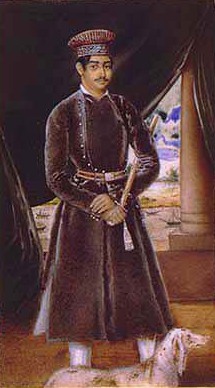The Zamindar's Footprint
 |
| Portrait of Mehtab Chand (1820-79), Zamindar of Burdwan in Bengal. Portrait was painted c.1840-45 and is an example of the "Company Style" of painting. |
When Bade Zamindar Babu died, it was a major celebration in the village of Kamahi. The Zamindar was not an evil man who tormented the poor villagers, but when a rich Hindu dies, the number of funeral rites performed makes it no less than a festival for poorer folk. The distribution of rice and clothes to Brahmins and other needy folk for the salvation of the dead man’s soul can usually sustain a village for days. And the politics of the class system made it impossible for such a prosperous land-owning family as Bade Zamindar Babu’s to shy away from ostentation, even for a solemn occasion as a funeral. Pundit Paramsukh was the presiding Bhatt for the funeral.
He had suffered at the hands of the late Zamindar, having been usuried on a loan taken for his daughter’s marriage from the latter twenty years ago, which he was still paying. After the corpse was finally consigned to the funeral pyre and the incantations said, the ashes of the dead old man were collected in an urn, to be transported as per Indian traditions to the Ganges where they would be immersed. This mighty river would supposedly wash off the sins of the deceased and save his soul. In some parts of India, Kamahi included, it is believed that if this urn is left overnight behind the kitchen door in the backyard, the form of the next birth of the person would be revealed in the form of a footprint in the ashes. Of course, this footprint is visible only to the Bhattji after the murmuring of some sacred chants.
Pundit Paramsukh grimaced at the end of the above-mentioned ceremony. Tears welled in his eyes. The Zamindar’s widow, sons, daughters-in-law and multitudinous grandchildren crowded around him. They were getting worried about the drain on the family’s resources, and were quite unhappy that they would end up far poorer than hoped for when the estate was divided among themselves. Much of the available liquidity had been squandered away in daan-dakshina, and if further money was to be required, they would have to catch hold of some debtor and make him cough up the remainder of his loan (which they knew he could never do), or seize his lands and commit some further atrocity. They looked for relief from Bhattji. It was not to come.
Read the rest of the story at Indian Periodical.
Comments